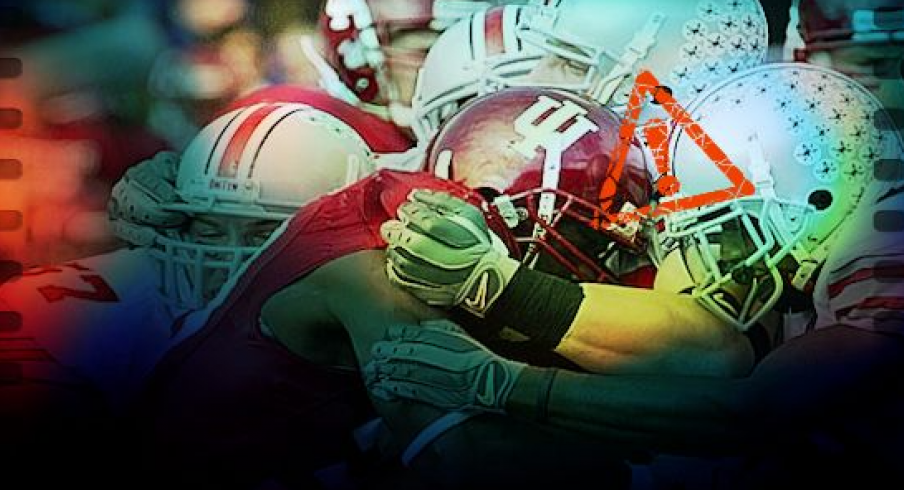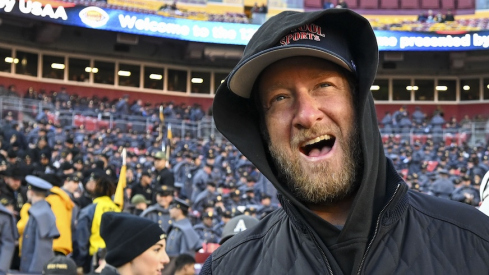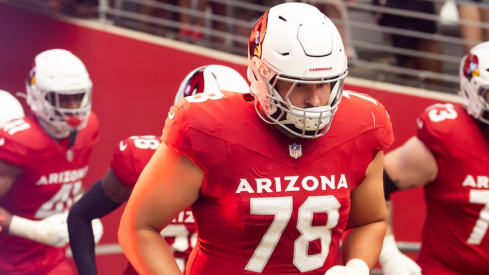Eighteen college football players died during the 1904 regular season.
That's a fresh corpse every Saturday afternoon, with bodies to spare. There were also 159 injuries that were classified as serious: Broken bones, twisted spines, pierced organs and other trauma you can't just rub dirt on and walk off.
The following year 19 died while 137 were seriously injured. Some of those fatalities occurred on high school fields, as football was rapidly growing in popularity and carnage was trickling down. The Chicago Tribune described that season as a "death harvest." Stanford, Cal, Columbia, Duke and Northwestern all dropped the sport.
That was football in its raw and most barbaric form. That sport doesn't exist anymore.
Over 100 years and as many safety enhancements later, college football is now primarily fighting against concussions. Death and impalement are freakishly rare. Players are largely protected from missiles like Ryan Shazier who probably would have killed someone had he played at the turn of the prior century.
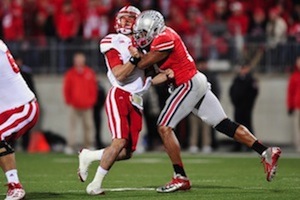 Leading with the arms and practically upright: Ejection?
Leading with the arms and practically upright: Ejection?
Disfigurement has been largely solved by advancements in medical science (Willis McGahee and Marcus Lattimore send their regards) and rules have changed to prevent injuries and encourage a safer style of play that is significantly removed from the veritable cockfights that were held at the turn of the last century.
While football is still inherently unsafe, it can always be made safer. Smart rules and changes that preserve it while reducing the potential for head injuries do exactly that.
Unfortunately, this season you will probably witness what happens when a dumb rule is installed.
Automatic ejections for targeting will make their debut next month, giving referees more power than ever to alter the course of a game - and season - on any given play. Since football speed has only increased as it has evolved, this has already made accurate officiating more difficult than ever.
But where the automatic ejection is concerned, officials have been told not to worry about accuracy. The directive is when in doubt, throw him out.
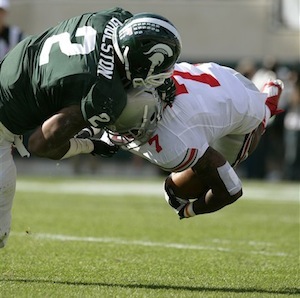 Who gets the ejection here? Both? Neither?
Who gets the ejection here? Both? Neither?
Abraham Lincoln said that the best way to get a bad law repealed was to enforce it strictly. He was a football visionary: Clearly he was referring to old Halo Rule that required a defined space for punt returners to catch the ball.
That failed rule debuted in 1983 and was predicated on giving punt returners two yards in all directions to field a kick. As with all rules, it was created to encourage changes in behavior. The problem was those changes didn't make football safer.
Gunners worked on their timing to deliberately hit the circumference of the halo right as the returner fielded the ball. That allowed them to compliantly obliterate someone and be celebrated for providing the violence we all love and celebrate.
To strictly enforce that rule, officials would calculate an invisible two-yard radius while a player running a sub-4.4 40 rapidly approached it. The ref would then deftly calculate πr² with his eyeballs and flag the play.
Or he wouldn't. The rule wasn't based on protecting players. It was based on solving impossible geometry.
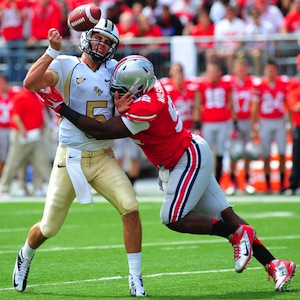 This is has ejection potential. Depends on the ref's whims.
This is has ejection potential. Depends on the ref's whims.
After watching too many men in striped shirts swiftly miscalculate the radius of an invisible circle on the fly, it was repealed before the 2003 season. Verdict: Nobody was any safer. Also: Everyone sucks at math.
And it was dead until last season when it was brought back after a decade off, not that you noticed. That's because it was enforced intelligently this time.
Apparently a two-yard halo isn't enough distance to protect players from terrifying defenders like Shazier and Christian Bryant when they have a head of steam. Jadeveon Clowney nearly killed Vincent Smith with barely more than five yards of runway. Two yards is as good as two inches.
Halo Rule 2.0 isn't about distance as much as it is about safety: It's now a one-yard halo, but timing big hits and weaponizing gunners is what's flagged now rather than breaching the invisible circle. Defenders have to break down and form-tackle punt returners to avoid being penalized.
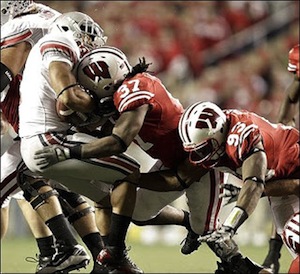 Wisconsin already gets away with everything. No worries.
Wisconsin already gets away with everything. No worries.
This critical change to the Halo Rule eliminated the doubt for officials and promoted safety by changing behavior. Or, exactly the opposite of the havoc that the new automatic ejection rule is poised to unleash this season.
The new targeting rule will fail because just like measuring the radius of an invisible circle, correctly diagnosing an instance of targeting at game speed is incredibly difficult. That's because as with the broken Halo Rule, it is enforced by snap-judgments.
Under the new directive, Clowney's Outback Bowl hit on Smith could have easily resulted in a 15-yard gain for Michigan, the ejection of the best player on the field despite a perfect form tackle and ultimately a loss instead of a win for South Carolina because when in doubt, throw him out.
A glimpse into how this might go down: A snap-judgment (inevitable) automatic ejection produces an equally inevitable a challenge flag. The game is abruptly stopped.
The head official [Bud Light commercial] will send the appeal to an octogenarian [Toyota truck commercial] with even worse eyesight [you're out of Cialis - call your doctor] in the replay booth, who will take too long [Pitbull, again] to make this critical decision. He'll fumble around the the TiVo remote [local news after the game] for awhile and a verdict will be made.
Oh, and coach - congratulations, now you're out of challenge flags for when the equally-inevitable shittiest non-targeting call of the day happens a few minutes from now. And no concussions have been prevented.
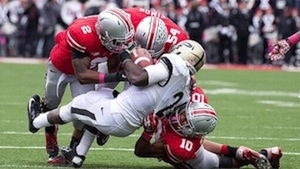 Three potential ejections on a single tackle.
Three potential ejections on a single tackle.
Getting punitive with incidental, accidental and imaginary contact does not promote player safety any more than the old Halo Rule did. And that sophomore who is just good enough for special teams duty on deeper rosters might just find himself bounty hunting.
Don't put it past some programs to take advantage of a rule whose punishment hurts one player the most. The Cobra Kais of college football wouldn't hesitate to use a player of reduced importance to take out an opposing team's Daniel LaRusso.
That's what team players do when their individual value is grossly exceeded by the needs of the team. It wouldn't be Clowney. It would be some kid Steve Spurrier calls son because he can't remember his name.
Most importantly, having officials base ejections on anything but evidence in a time crunch is a terrible idea. At the same time those deliberate, purposeful cases of targeting still need to be limited, without tolerance.
So here's a crazy idea: Throw the flag and call a running-into-the-kicker five-yarder for close calls. Leave the personal fouls for the no-doubters, which then get automatically reviewed by the conference and are all subject to next-game suspensions.
If you want to get even more serious about promoting a culture of safety, adopt the yellow/red card system from soccer and apply it to the guilty. Two yellows or one red result in a next-game suspension. Four yellows or two reds gets a five-game ban. Make repeated headhunting as punitive as selling a Fiesta Bowl ring.
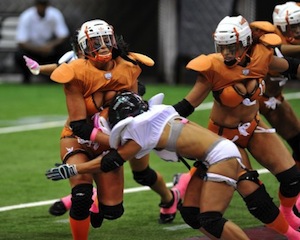 Just aim for the giant breasts. It's the only way to be sure.
Just aim for the giant breasts. It's the only way to be sure.
That productively addresses behavior just as Halo Rule 2.0 does instead of relying on the whims of officials who don't always have the best angles. How many times do you see a back judge throw a flag on something 25 yards away? That ref can now eject anyone on the field in an instant, with doubts.
It took 20 years of the broken Halo Rule and then ten more years without it to finally get it right. Too many game stoppages, controversial ejections and not enough reduction in concussions will ultimately do the same to when in doubt, throw them out. How long and how damaging it will be to the game in the meantime remains to be seen.
Following that "death harvest" of 1905, football fatalities fell to just 11 deaths in each of the 1906 and 1907 seasons. They spiked again in 1909, which ignited the first purposeful changes to the game to make it safer, which included legalization of the forward pass and the creation of the neutral zone.
What they didn't do was tell officials when in doubt, throw them out. They were smarter than that.
